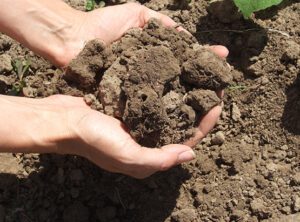Twenty-five years ago, when Gary Manternach first began working with Midwestern BioAg, few would have predicted that topics like sulfur, calcium, micronutrients, and soil biology would be a vital part of mainstream agriculture today. “The whole industry is talking sulfur now,” notes Manternach as an example. “You can’t open up a magazine without reading about biology.”
Today, Manternach successfully farms his Iowa silt-loam acres by focusing on both soil health and profits. Working with soil health to build yields and profitability makes farming a pursuit he enjoys and hopes he will be able to pass on to the next generation of his family.
Almost all of his 640 acres are corn-on-corn, grown successfully and profitably because he follows the healthy-soil concepts he has learned from Midwestern BioAg — nurturing his soil life, applying quality nutrients from quality sources to address crop fertilizer and soil corrective requirements, and avoiding overtillage — all practices aimed toward improving efficiency and increasing yield while simultaneously building soil health on his farm. “I want to keep that good soil health,” adds Manternach.
One way Manternach assesses his soil health is by evaluating the number of earthworms found in his fields. Why are they important? High populations are “a great sign of good soil: structure, fertility, the whole works,” says Manternach. “That includes great nutrient cycling,” he added.
The whole industry is talking sulfur now,” notes Manternach. “You can’t open up a magazine without reading about biology.
By performing a slake test, Manternach’s Midwestern BioAg Consultant, Bob Yanda of Monticello, Iowa, confirmed another of Manternach’s observations — that his soils absorb water better than the surrounding ground. Visual differences are obvious after a heavy rain. “You can see a lot of neighboring ground where the yellowing on their corn was more visible compared to mine,” Manternach notes.
His most important measure, however, is profitability, which he judges by net dollars per acre.
Back in 1989, before becoming a BioAg customer, yields were stagnating, Gary Manternach recalls. “We bulk-spread fertilizer, soil tested our fields, and it seemed like the only recommendation we received was to put on more potash.” That advice didn’t make sense to him, because with livestock manure from their feeder cattle operation “you wouldn’t think you’d need that.” But when a BioAg consultant knocked on his door with new ideas and new products to maximize his operation, Manternach saw the potential and value of going beyond N-P-K to meet his crops’ nutrient needs. “We needed to apply calcium to help get things in balance.” With the help of his consultant, Manternach selected Midwestern BioAg’s Bio-Cal® as a calcium source. “Calcium is a big help with water infiltration and in keeping that cake-like soil structure,” he noted.
Initially, Manternach disced-in fertilizer during planting, but “now we’re zone-tilling so we’re putting it right in the root zone. It’s more efficient, and requires less tillage.” They utilize light vertical-till and strip-till, plus ag technology applications such as GPS and auto steer. Their goal is to “get the corn root closer to that fertilizer zone.”
Managing crop residues is also an important aspect of Manternach’s farming approach. By recycling the nutrients in the residues back into the ground, Manternach helps feed next year’s crop and builds organic matter in the soil. Using a corn head with a crusher that physically breaks down corn leaves and stalks after harvest, Manternach then leverages the microbes in his soil to finish decomposition. Additionally, he bales as much residue as he can for bedding for his 650 feeder steers, and then returns that manure to his fields. The combination of stalks and manure speeds decomposition and generates a yield increase later in the growing season. Where manure is applied, “the ground is yielding better,” a 10 to 20 bu/acre bump. “I see it all the time,” Manternach added.
A product the Iowa farmer has recently added to his operation is Midwestern BioAg’s molasses-based fertilizer Boost™. With a 4-0-3-2S-.5Mg analysis, Boost is a liquid fertilizer, a surfactant that provides drift control, a biological stimulant, and a nitrogen stabilizer. “It’s great to use a fertilizer to help your chemicals and stimulate your biology,” says Manternach.
Manternach uses a variety of nitrogen sources in addition to what’s found in BioAg’s starter fertilizers. Manternach uses a slow-release nitrogen source, plus additional 28% or 32% with chemical applications. He spreads livestock manure on about half of his land. A small part of his acreage, usually about 30 acres, is in alfalfa, and when plowing down a stand, he credits that nitrogen as well.
His fertilizer program for corn-on-corn is a custom blend with an analysis of 19-4-8 and an additional 8 units of sulfur. Manternach uses micronutrients in all his blends.
Manternach applies nitrogen with his planter (side of row) and in-furrow with Midwestern BioAg’s L-CBF 10-14-1. Boost is also broadcasted to provide additional nitrogen. Bio-Cal, a Midwestern BioAg exclusive product he’s used for many years, is applied about every three to four years to his row crops and always ahead of alfalfa.
Among the advantages of working with BioAg, Manternach lists economic stability, improved crop yields, more enjoyment in farming, improved soil health, and knowledge, which allows him to farm to his full potential. Why work with Midwestern BioAg? He answered with a question. Ask yourself “Are you satisfied where you are at? If not, and you want to learn more, BioAg is something you ought to look at.”

